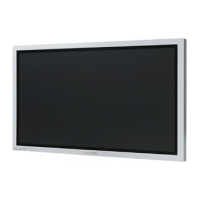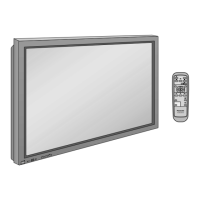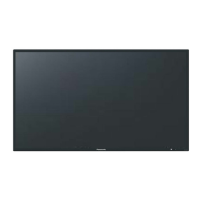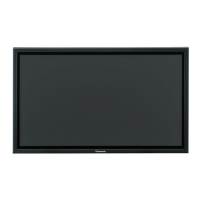Do you have a question about the Panasonic TH-49SF1HU and is the answer not in the manual?
Warnings about fire and shock hazards, and exposure to moisture.
Safety instructions for the power plug, fuse, and grounding.
Guidelines for safe installation using optional accessories.
Requirements for installation, including environment and ventilation.
Connects PC for display control via RS-232C.
Automatically adjusts position and size for PC inputs.
Selects preset picture modes for different viewing conditions.
Saves current picture settings as a profile for later use.
Applies previously saved picture settings.
Detailed steps to save picture settings as a profile.
Steps to load saved picture profiles using numeric buttons.
Configures input signal parameters like format, noise reduction, and range.
Settings to reduce power consumption and enable auto-off functions.
Configuration for LAN connection, IP addresses, and network control.
Configures display alignment for multi-display setups.
Configures power saving modes like On, Custom, and No Signal Power Off.
Manages power on/off automatically based on signal detection for specific inputs.
Enables dividing the display for enlarged images and sets scales.
Selects RS-232C control terminal for serial communication.
Enables or disables LAN control of the unit.
Enables the player and configures resume playback.
Automatically selects the next input when no signal is detected.
Automatically switches to backup input on video interruption.
Outlines requirements for network-connected computers.
Advice on wiring work, transmission distance, and cable routing.
How to control the unit via LAN using commands.
Lists commands for power, input, and shutter control via PJLink.
Configures computer network settings and browser options.
Requirements for using the web browser control function.
How administrators can change passwords.
Steps to configure LAN settings through the web interface.
Details sections like Tools, Power, Volume, Input, and Image Quality.
Details supported devices and file preparation for media playback.
Lists supported file formats and codecs for media playback.
Steps to copy display settings to a USB memory device.
Common problems related to picture quality and sound.
Warnings about fire and shock hazards, and exposure to moisture.
Safety instructions for the power plug, fuse, and grounding.
Guidelines for safe installation using optional accessories.
Requirements for installation, including environment and ventilation.
Connects PC for display control via RS-232C.
Automatically adjusts position and size for PC inputs.
Selects preset picture modes for different viewing conditions.
Saves current picture settings as a profile for later use.
Applies previously saved picture settings.
Detailed steps to save picture settings as a profile.
Steps to load saved picture profiles using numeric buttons.
Configures input signal parameters like format, noise reduction, and range.
Settings to reduce power consumption and enable auto-off functions.
Configuration for LAN connection, IP addresses, and network control.
Configures display alignment for multi-display setups.
Configures power saving modes like On, Custom, and No Signal Power Off.
Manages power on/off automatically based on signal detection for specific inputs.
Enables dividing the display for enlarged images and sets scales.
Selects RS-232C control terminal for serial communication.
Enables or disables LAN control of the unit.
Enables the player and configures resume playback.
Automatically selects the next input when no signal is detected.
Automatically switches to backup input on video interruption.
Outlines requirements for network-connected computers.
Advice on wiring work, transmission distance, and cable routing.
How to control the unit via LAN using commands.
Lists commands for power, input, and shutter control via PJLink.
Configures computer network settings and browser options.
Requirements for using the web browser control function.
How administrators can change passwords.
Steps to configure LAN settings through the web interface.
Details sections like Tools, Power, Volume, Input, and Image Quality.
Details supported devices and file preparation for media playback.
Lists supported file formats and codecs for media playback.
Steps to copy display settings to a USB memory device.
Common problems related to picture quality and sound.
| Panel Technology | IPS |
|---|---|
| Diagonal Size | 49 inches |
| Contrast Ratio | 1300:1 |
| Response Time | 8 ms |
| Viewing Angle (H/V) | 178°/178° |
| External Control Terminals | RS-232C, LAN |
| VESA Mounting | 400 x 400 mm |
| Input Terminals | DVI-D, USB |
| Output Terminals | Audio Out |
| Brightness | 350 cd/m² |












